It looks like you're using an Ad Blocker.
Please white-list or disable AboveTopSecret.com in your ad-blocking tool.
Thank you.
Some features of ATS will be disabled while you continue to use an ad-blocker.
31
share:
Stumbled into this and it's been fascinating reading. Due to coastal erosion in the Kuskokwim delta region of the Yukon artifacts were washing up on
beaches. This led to the university of Aberdeen getting involved and working with the Yu'pik people and are now literally rescuing the site from
oblivion. It started in 2009 and has been ongoing. The yu'pik people have had their stories validated thru this and all the items will be sent back
to
Quinhagak to be housed with the Yupik people in a new museum.
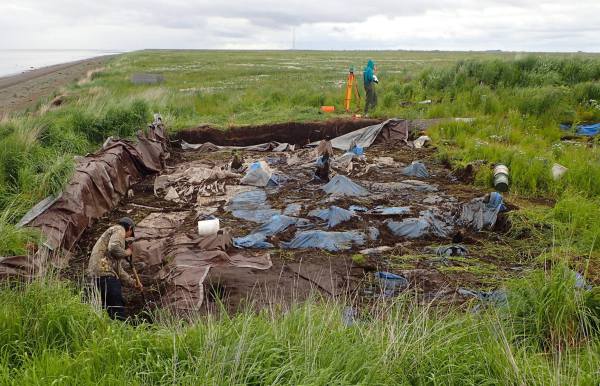
The sheer amount of artifacts recovered has been stunning and range back over hundreds of years. Everything from pottery, to cordage to masks and dolls have been recovered. Due to the break in historical knowledge the Yu'pik people are also recovering their past history with these finds and are also working with the team digging on site.
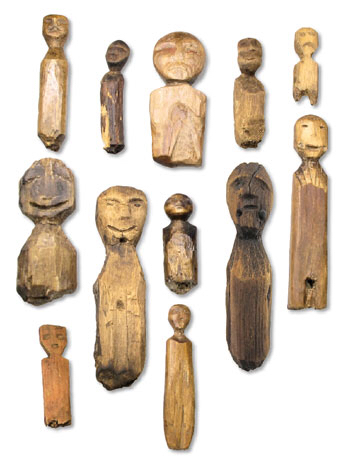
And more artifacts
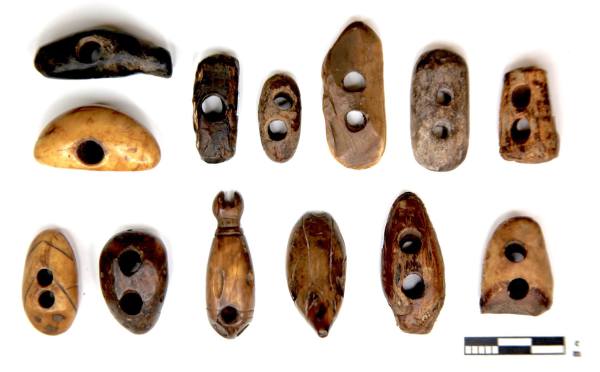
There is a blog site dedicated to this site and covers everything from working conditions to hypotheis as they are formed then refined as the dig continues. The students are deeply involved as is the local community. Despite the hard work everyone remains cheerful and some of the video's of them dealing with the bugs on site are amusing. The blog is well done and just filled with an overwhelming amount of information.
I know this isn't as ancient as some of the topics here, but it's breathtaking and one heck of a good read.
nunalleq.wordpress.com...
Quinhagak to be housed with the Yupik people in a new museum.
Nunalleq means ‘the OldVillage’ in Yup’ik. Previous years excavations (2009 & 2010) reveal that this ‘old village’ dates back at least 700 years. It is a multi-period prehistoric (or precontact) Yup’ik winter village site. The waterlogged frozen tundra preserves organic material to an incredible degree. Everything from grass ropes, salmon berry seeds and head lice, along with an abundance of wooden and lithic artefacts and faunal remains builds the knowledge of a Yup’ik prehistory that up until now has been very little known or studied.

Mike Smith pulls back the tarp at the Nunalleq site to reveal a house floor 4 centuries old, still in great condition despite being covered by backfill for the last two years. This level will be our starting point for the 2017 season.
The sheer amount of artifacts recovered has been stunning and range back over hundreds of years. Everything from pottery, to cordage to masks and dolls have been recovered. Due to the break in historical knowledge the Yu'pik people are also recovering their past history with these finds and are also working with the team digging on site.

And more artifacts

Toggles for attaching harpoon cords to the main harpoon line. Many are carved into the shape of sea mammals. Hunting gear was often beautifully made to show respect to the animals.
There is a blog site dedicated to this site and covers everything from working conditions to hypotheis as they are formed then refined as the dig continues. The students are deeply involved as is the local community. Despite the hard work everyone remains cheerful and some of the video's of them dealing with the bugs on site are amusing. The blog is well done and just filled with an overwhelming amount of information.
I know this isn't as ancient as some of the topics here, but it's breathtaking and one heck of a good read.
nunalleq.wordpress.com...
Knecht said the dates of the objects are important, because they bracket a particularly intense chill in the so-called Little Ice Age, an abrupt period of colder-than-usual temperatures and ice advances recorded between 1430 to 1455. It wiped out the Norse settlements in Greenland and hammered crops throughout the northern hemisphere of the Old World. The destruction was well documented in court records in Europe and Asia. But how did it affect Alaskans?
This is just how close to the Bering Sea the site is. It's literally falling into the water.
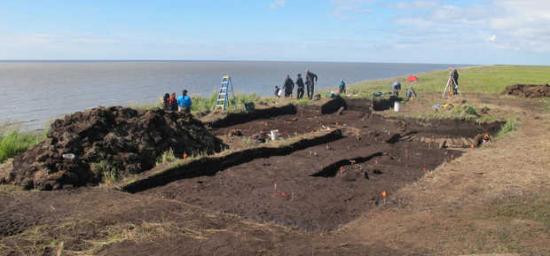
Knecht thinks the old village was likely a winter gathering place on the Arolik River, south of modern Quinhagak. It was abandoned after the river shifted. The land is famously moving in this part of the world, constantly rearranged by rivers and ocean currents. The shoreline is rapidly eroding at the old village. "Most of (the site) may have been washed away already," Knecht said. "We may just be looking at a portion of it. Maybe a quarter of the original site is left -- and it's going fast." The ocean has already taken out the original dig site, he said. "If we hadn't done the work we did in 2009, 2010, everything, about 8,000 pieces, would have been lost. We're just barely staying ahead of it. It's kind of an emergency."
www.archeolog-home.com...
One of the most amazing things is the involvement of the local Yu'pik People. They come to work with the archeologists and originally funded the dig
themselves.
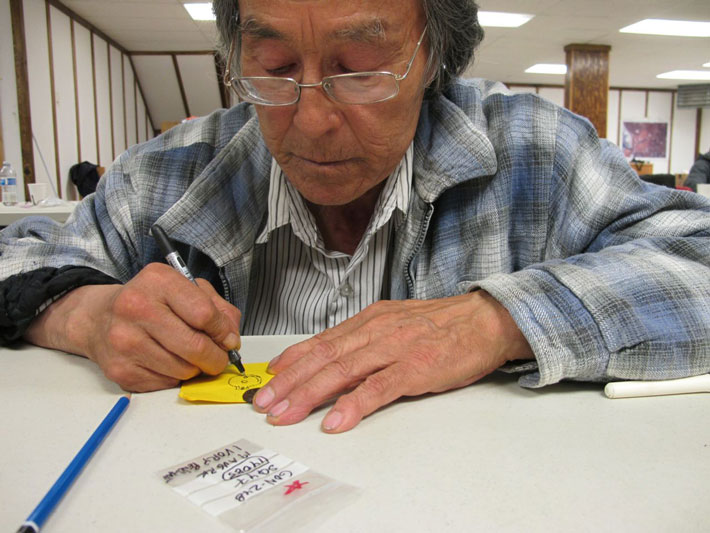
"(Courtesy Rick Knecht, University of Aberdeen) Quinhagak elder and carver John Smith sketches an ivory pendant so he can make a modern copy as a gift for his grandson, who had found the artifact at the site earlier in the day."
Sources;
www.adn.com...
www.archaeology.org...
In a region where tradition says old treasures should remain undisturbed, the Yup'ik people of Quinhagak invited the archaeologists in.
Why? "Because we had nothing," said Warren Jones, president of the village corporation, Qanirtuuq Inc., which owns the dig site land. Cultural elements, including language and traditional dance, were stifled by the Moravian missionaries and nearly lost, said Jones, a behind-the-scenes leader in Quinhagak, home to about 700 people on Kuskokwim Bay some 70 miles southwest of Bethel.
Growing up "all I heard about was the church stuff, not what our ancestors did," he said. They had stories but not ancient harpoons, stone ulus or little figurines of mythical creatures.

"(Courtesy Rick Knecht, University of Aberdeen) Quinhagak elder and carver John Smith sketches an ivory pendant so he can make a modern copy as a gift for his grandson, who had found the artifact at the site earlier in the day."
Convincing elders
Before the project began in 2009, residents sometimes found stuff washed up on the beach a few miles from Quinhagak but assumed the source had washed away. Warren Jones, then the village land manager, heard that a famous Alaska archaeologist -- Knecht -- was working nearby on Nunivak Island in the Bering Sea and invited him to take a look.
"We stopped by and followed a trail of wooden artifacts along the beach. And we found the mother lode here, eroding out," Knecht said.
Jones acted fast. He won the support of elders by speaking to them one-on-one. Then he convinced his corporation board to buy in. It spent more than $200,000 to support the archaeologists in the initial years.
Sources;
www.adn.com...
www.archaeology.org...
Am I the only one who sees a bunch of ancient sex toys in that one pic? Cool find tho I love reading about stuff like this. It's neat that the
people get some of their lost history back.
a reply to: Caver78
This is so wonderful and fascinating! Thank you for doing justice to the finds in this thread!
History is such a treat for all humanity. The mask is breathtaking and so perfectly preserved! It looks like it was just carved! And the totems are marvelous works as well. Smiling faces, they must have been quite a peaceful people!
This is so wonderful and fascinating! Thank you for doing justice to the finds in this thread!
History is such a treat for all humanity. The mask is breathtaking and so perfectly preserved! It looks like it was just carved! And the totems are marvelous works as well. Smiling faces, they must have been quite a peaceful people!
a reply to: Caver78
Thanks for posting that! Fascinating site...and you missed a lecture on it in Peterborough a couple of years back: "Community archaeology and landscape ecology in the thermokarst --- recent work at the early Yupik site of Nunalleq, Alaska." It was a lot more entertaining than the title might suggest.
facebook link
S&F4U!
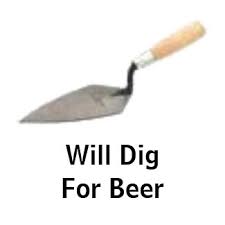
Thanks for posting that! Fascinating site...and you missed a lecture on it in Peterborough a couple of years back: "Community archaeology and landscape ecology in the thermokarst --- recent work at the early Yupik site of Nunalleq, Alaska." It was a lot more entertaining than the title might suggest.
facebook link
S&F4U!

edit on 10-7-2017 by JohnnyCanuck because: adding link
a reply to: SargonThrall
Glad the info was enjoyed!
The Site with the associated blog site so people can follow along was totally unexpected. It makes the site just come to life instead of waiting 5 plus years to read a dry abstract. That the entire community is involved is just goosebump inducing. We never get to see this level of involvement, it's just amazing.
Glad the info was enjoyed!
The Site with the associated blog site so people can follow along was totally unexpected. It makes the site just come to life instead of waiting 5 plus years to read a dry abstract. That the entire community is involved is just goosebump inducing. We never get to see this level of involvement, it's just amazing.
a reply to: JohnnyCanuck
I'd of been in the front row. Grins!
Sadly I have to admit I'm a little late to this since it began back in 2009, but playing catch-up has been some fantastic reading. The video tours on the blog site were both educational and a hoot! All the dedicated work of cataloging everything and of course the practical aspect of the mosquito fans. All the stuff we don't think about but the team takes you thru step by step.
It was interesting about the oral history being proved out and literally watching thru video's and the blog to see and hear everyones first impressions as things were found and the story developed. We miss that with the more well known archeological sites. Usually the people are centuries deceased and it's up to the archeologists "best educated guesses".
I was actually shocked this topic hadn't been posted yet!!
I'd of been in the front row. Grins!
Sadly I have to admit I'm a little late to this since it began back in 2009, but playing catch-up has been some fantastic reading. The video tours on the blog site were both educational and a hoot! All the dedicated work of cataloging everything and of course the practical aspect of the mosquito fans. All the stuff we don't think about but the team takes you thru step by step.
It was interesting about the oral history being proved out and literally watching thru video's and the blog to see and hear everyones first impressions as things were found and the story developed. We miss that with the more well known archeological sites. Usually the people are centuries deceased and it's up to the archeologists "best educated guesses".
I was actually shocked this topic hadn't been posted yet!!
a reply to: Caver78
Hi Caver, thanks for posting.
I am struck at the differing attitudes between the indigenous people of Canada and Alaska and the lower 48, with regards to the past.
It seems many groups in the lower 48 are content to and actively try to bury their own history, in a way that has essentially become religious fundementalism.
As someone with a native heritage, my grand mother was full blooded Mono or Miwok, more likley mono, I will never know because she died when my father was a child, I want to know the stories of the ancestors, so they are not lost to the past as so many have been.
Hi Caver, thanks for posting.
I am struck at the differing attitudes between the indigenous people of Canada and Alaska and the lower 48, with regards to the past.
It seems many groups in the lower 48 are content to and actively try to bury their own history, in a way that has essentially become religious fundementalism.
As someone with a native heritage, my grand mother was full blooded Mono or Miwok, more likley mono, I will never know because she died when my father was a child, I want to know the stories of the ancestors, so they are not lost to the past as so many have been.
a reply to: punkinworks10
I wouldn't say "all's lost" just yet. Things are coming back and now more than ever with the internet & FB, Nations are
actively putting things out there.
what-when-how.com...
Lost relatives are happily welcomed back.
I wouldn't say "all's lost" just yet. Things are coming back and now more than ever with the internet & FB, Nations are
actively putting things out there.
what-when-how.com...
Lost relatives are happily welcomed back.
I didnt know about this, so thanks for posting it
Archaeology at its best
Archaeology at its best
originally posted by: Butterfinger
I'm amazed at that mask!
I'm surprised that they didn't remove the piece as pedestaled and let the conservators flip it.
Last weeks "finds" at the site. It's absolutely amazing to me that the team of archeologists keep the blog both updated and humorous at the same time.
It gives you the distinct feeling of actually being included, despite not being there.
Below is the "Find of the Day" for July 13,2017
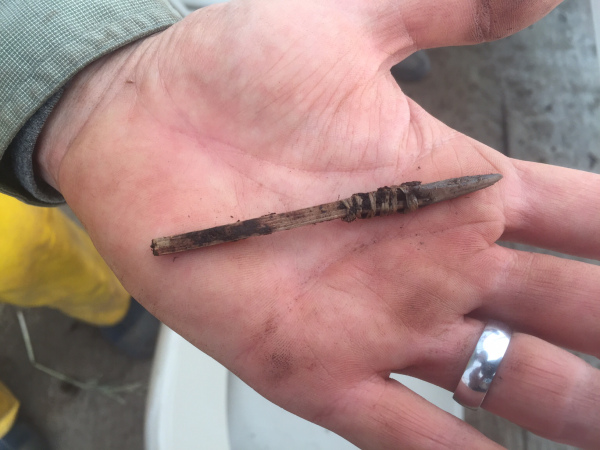
Don't know how many of you have tried using grass to make anything out of, much less binding a spear point, but it unravels on me every time! I can't imagine that this artifact is this delicate, lasted this long, and the grass stayed put holding the spearhead in place!!
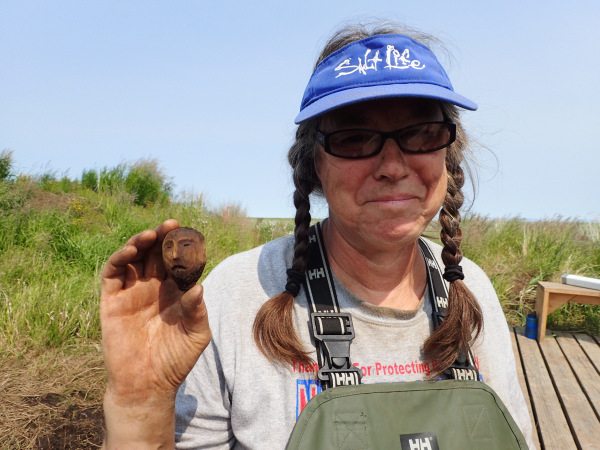
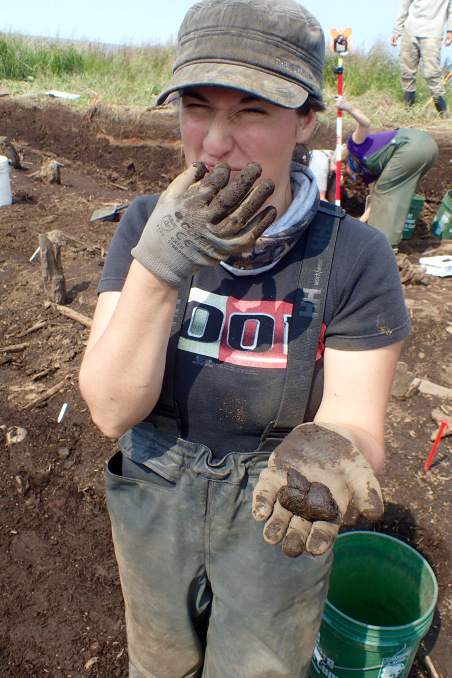
Ah the romance of being an archeologist! It's apparently not all "Indiana Jones" altho a find is still a find. I guess, maybe? For whatever reason I'd assumed at least the dog-poo would have biodegraded, but nope! It's there in all it's historic glory. Probably not what this young lady had in mind this particular morning when she went to the dig site.
nunalleq.wordpress.com...
Below is the "Find of the Day" for July 13,2017

The artefact of the day is a little toy (or model) spear. It is only 10 cm long, made of wood with an ivory inset for spear point, and grass wrapped around the shaft to hold the tip in place. It was found by John in the north-eastern boardwalk.
Don't know how many of you have tried using grass to make anything out of, much less binding a spear point, but it unravels on me every time! I can't imagine that this artifact is this delicate, lasted this long, and the grass stayed put holding the spearhead in place!!

Joni with an exquisitely carved doll head she found in house floor on top of a boardwalk

Ah the romance of being an archeologist! It's apparently not all "Indiana Jones" altho a find is still a find. I guess, maybe? For whatever reason I'd assumed at least the dog-poo would have biodegraded, but nope! It's there in all it's historic glory. Probably not what this young lady had in mind this particular morning when she went to the dig site.
The high level of preservation is also keeping other treasures for us; we have found an abundance of coprolites – poop in plain english. Mostly dog we think. Disgusting as it may sound, these nuggets contain a lot of information on diet, deceases, parasites…
nunalleq.wordpress.com...
edit on 14-7-2017 by Caver78 because: (no reason given)
new topics
-
Thousands Of Young Ukrainian Men Trying To Flee The Country To Avoid Conscription And The War
Other Current Events: 3 hours ago -
12 jurors selected in Trump criminal trial
US Political Madness: 6 hours ago -
Iran launches Retalliation Strike 4.18.24
World War Three: 6 hours ago -
Israeli Missile Strikes in Iran, Explosions in Syria + Iraq
World War Three: 6 hours ago
top topics
-
George Knapp AMA on DI
Area 51 and other Facilities: 12 hours ago, 25 flags -
Israeli Missile Strikes in Iran, Explosions in Syria + Iraq
World War Three: 6 hours ago, 15 flags -
Louisiana Lawmakers Seek to Limit Public Access to Government Records
Political Issues: 14 hours ago, 7 flags -
Iran launches Retalliation Strike 4.18.24
World War Three: 6 hours ago, 6 flags -
Not Aliens but a Nazi Occult Inspired and then Science Rendered Design.
Aliens and UFOs: 12 hours ago, 5 flags -
12 jurors selected in Trump criminal trial
US Political Madness: 6 hours ago, 4 flags -
The Tories may be wiped out after the Election - Serves them Right
Regional Politics: 16 hours ago, 3 flags -
Thousands Of Young Ukrainian Men Trying To Flee The Country To Avoid Conscription And The War
Other Current Events: 3 hours ago, 3 flags
active topics
-
It has begun... Iran begins attack on Israel, launches tons of drones towards the country
World War Three • 888 • : DISRAELI2 -
African "Newcomers" Tell NYC They Don't Like the Free Food or Shelter They've Been Given
Social Issues and Civil Unrest • 18 • : GENERAL EYES -
-@TH3WH17ERABB17- -Q- ---TIME TO SHOW THE WORLD--- -Part- --44--
Dissecting Disinformation • 537 • : brewtiger123 -
Graham Hancock being proven right all along about ancient humans in America.
Ancient & Lost Civilizations • 105 • : bluesfreak2 -
Thousands Of Young Ukrainian Men Trying To Flee The Country To Avoid Conscription And The War
Other Current Events • 2 • : DerBeobachter2 -
The Tories may be wiped out after the Election - Serves them Right
Regional Politics • 23 • : andy06shake -
Mandela Effect - It Happened to Me!
The Gray Area • 109 • : ArMaP -
Mood Music Part VI
Music • 3058 • : Hellmutt -
Fossils in Greece Suggest Human Ancestors Evolved in Europe, Not Africa
Origins and Creationism • 60 • : whereislogic -
Scarface does Tiny Desk Concert
Music • 7 • : sitrose
31
